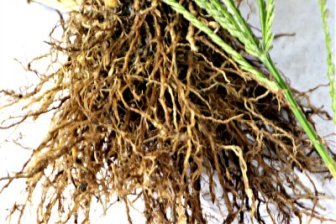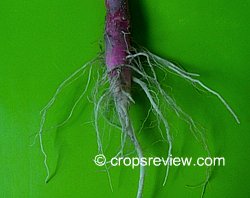The fibrous root system is one of two main types of roots according to the origin of development and branching pattern in the angiosperms.
The other is the taproot system.
Generally, plants with a taproot system are deep-rooted in comparison with those having fibrous types.
The taproot system enables the plant to anchor better to the soil and obtain water from deeper sources.
In contrast, shallow-rooted plants are more susceptible to drought but they are quick to absorb surface and irrigation water and thus have the ability to respond quickly to fertilizer application.
In order to enhance the development of more lateral roots in tap-rooted plants, pruning of the taproot is practiced, as in plant nurseries.
The practice is also a standard procedure with bonsai trees.
The primary root which develops from a radicle and becomes dominant is called a taproot, as in carrot.
Roots that develop from other roots are generally called lateral roots; those that arise from other plant organs rather than the root, such as from stems or leaves, are called adventitious roots.

A taproot system is one in which the primary root becomes the main root of the plant with minimal branching consisting of secondary, smaller lateral roots.
The taproot system occurs in dicot plants and is one of the bases of distinguishing these plants from the monocots which generally have fibrous roots.
In plants having a taproot system, the trunk-like primary root develops directly from the embryonic root called radicle and grows downward into the soil.
From this taproot, lateral roots develop which may initially grow horizontally and then turn downward.
These roots repeatedly form finer roots which terminate in a root tip with a minute, dome-shaped, protective root cap at the topmost part.
As the root grows, it pushes its root cap forward, probing the soil and absorbing water and nutrients mainly through fine root hairs.
The root hairs are extensions of the epidermis which develop in the region of differentiation.
These plant organs are short-lived and constantly replaced.

In grasses and other monocots including lilies and palm plants, the root system is a fibrous root system consisting of a dense mass of slender, adventitious roots that arise from the stem.
A fibrous root system has no single large taproot because the embryonic root dies back when the plant is still young.
The roots grow downward and outward from the stem, branching repeatedly to form a mass of fine roots.
Specialized Taproot and Fibrous Root Types
There are various specialized root types such as the storage root, aerial root, contractile root, haustoria, prop roots, pneumatophores, and buttress roots (Simpson 2010).
These are briefly described:
1. Storage roots
These consist of thickened roots due to the accumulation of high-energy storage compounds, usually starch.
These are further subclassified into fleshy and tuberous roots.
Examples of crops with fleshy roots are the carrot, ginseng (Panax), and sugar beet while those with tuberous roots are the sweet potato, cassava, and yam bean (Click here to read Starchy Root Crops, Tuber Crops, and Corm Crops).
2. Aerial roots
These are adventitious roots that are common in many epiphytes such as in the monocot plants belonging to the arum or gabi family (Araceae) and orchid family (Orchidaceae).
In general, these fibrous roots remain aerial, i.e. they do not enter the soil.
Depending on the plant species, aerial roots perform special functions such as water retention, photosynthesis, and support.
3. Contractile roots
As in many plants that form bulbs (e.g. lily) or corms (e.g. Gladiolus), these fibrous roots contract vertically to pull the plant downward into the soil.
These roots are also found in ginseng (Panax).
According to Moore et al. 2003, contractile roots can shrink more than 50% in only a few weeks.
4. Haustoria
These are specialized roots in parasitic plants that penetrate the tissues of a host plant, as in watchweed (Striga) and broomrape (Orobanche).
5. Prop roots
These are aerial roots that arise from a stem and subsequently sink into the soil to provide additional support to the plant such as in corn and Ficus.
In the banyan tree (Ficus benghalensis), these modified roots provide additional support to the branches similar to the pillars of a bridge which make it possible for these branches to extend horizontally to great distances.
The prop roots of Rhyzophora stylosa are also capable of photosynthesis (Kitaya et al. 2002).
6. Pneumatophores
These are specialized roots in some plants that grow in watery places and which function mainly for oxygen absorption.
The raised pneumatophores of many mangrove species including Sonneratia alba and Avicennia marina and the “knees” or knee pneumatophores of Bruguiera gymnorrhiza and bald cypress (Taxodium distichum) serve as the entry of atmospheric oxygen which diffuses to roots growing in anaerobic soils.
The “knees” are described as a cone-shaped extension of the root that protrudes from the ground.
The oxygen from the air diffuses to the pneumatophores through aerenchyma cells which compose as much as 80% of these roots (Moore et al. 2003).
7. Buttress roots
These are enlarged, often thickened roots that spread horizontally from the base of trees to provide additional support.
In tropical trees like fig (Ficus) that are shallow-rooted, large buttress roots are formed at the base of their trunks.
REFERENCES
- AGROFORESTRY SEEDS CIRCULAR, No. 3. March 1993. UPLB, Los Banos, Laguna: AFSICH. p. 30.
- CHEVRON CHEMICAL COMPANY. 1984. Ortho Agronomy Handbook. San Francisco, CA: Chevron Chemical Company. 454 p.
- FEININGER A. 1968. Trees. (1978 reprint). NY: The Viking Press. 116 p.
- FLORES HE, DAI Y, CUELLO JI, MALDONADO-MENDOZA IE, LOYOLA-VARGAS VM. 1993. Green roots: photosynthesis and photoautotrophy in an underground plant organ. Plant Physiol. 101: 363-371. Retrieved November 27, 2010, from http://www.plantphysiol.org/cgi/reprint/101/2/363.pdf.
- GOMEZ FP, PRADO CHBA. 2007. Ecophysiology of coconut palm under water stress. Brazilian Journal of Plant Physiology. Print version ISSN 1677-0420. Retrieved December 8, 2010, from http://www.scielo.br/scielo.php?pid=S1677-04202007000400008&script;=sci_arttext.
- http://www2.bioversityinternational.org/publications/Web_version/108/ch02.htm#Top OfPage, accessed December 7, 2010.
- KITAYA Y, YABUKI K, KIYOTA M, TANI A, HIRANO T, AIGA I. 2002. Gas exchange and oxygen concentration in pneumatophores and prop roots of four mangrove species. Retrieved December 7, 2010, from http://www.springerlink.com/content/0wtyb14gmpjc3qqu/.
- MADER SS. 1993. Biology Part 4: Plant Structure and Function. 4th ed. Dubuque, Iowa: Wm. C. Brown Publishers. p. 474-493.
- MOORE R, CLARK WD, VODOPICH DS. 2003. Botany. 2nd ed. Boston, Massachusetts: McGraw-Hill. 919 p.
- SIMPSON MG. 2010. Plant Systematics. 2nd ed. San Diego, California: Elsevier Inc. 740 p.
- WENT FW, THE EDITORS OF LIFE. 1963. The Plants. NY: Time Incorporated. p. 73-98.
